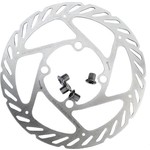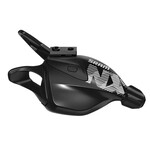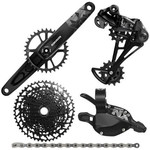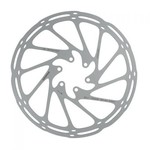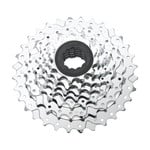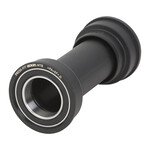SRAM was founded on a single product in 1987 and introduced the Grip Shift (or twist shift) shifter to the road bike market in 1988. In 1991 that technology was adapted for mountain bikes, and SRAM quickly grew.
In 1995, eager to expand, SRAM introduced their first mountain bike rear derailleur, dubbed ESP, that featured a new and unique 1:1 cable actuation ratio that was more tolerant of cable contamination and easier to set than the competitors. The new derailleur was designed to pair perfectly with SRAM’s ESP Grip Shifters, and this was a critical first step for SRAM toward producing a complete shifting system.
SRAM was eager to grow, both by acquisition and product development. By 1997, SRAM purchased Sachs, a legendary German manufacturer with expertise in chains and gearing. Sachs provided SRAM with a group of experienced metallurgists and engineers as well as a successful chain and internally geared hub production line.
SRAM’s released its first XO rear derailleur in 2001. It was a complete redesign of SRAM’s existing ESP derailleurs, and the goal was to be undeniably best in class. The introduction of SRAM’s first high-end derailleur marked a turning point for the company’s mountain bike groups.
In 2002, SRAM acquired suspension manufacturer, RockShox. RockShox was one of the most recognizable brands in cycling and an industry innovator who introduced suspension and reshaped mountain biking for the entire world.
Avid was SRAM’s next acquisition in the spring of 2004. Avid produced popular hydraulic disc brakes and gave SRAM more means to compete in the component market. Later that same year SRAM purchased Truvativ, a crank, bottom bracket, and chainring manufacturer. With Truvativ as part of the SRAM family, the company could finally sell a complete drivetrain.
Although SRAM began as a manufacturer of road bike shifters, in 1993, the company mainly served the rapidly growing mountain bike market. By 2004, SRAM planned a return to the road and began the development of two new road groupsets. SRAM brought Force and Rival to market in 2006 and Force was raced in the Tour de France the following year. The group used a new proprietary shifting technology known as DoubleTap. The technology allows the rider to shift a derailleur in both directions using a single shifter paddle.
In 2007, SRAM acquired leading wheel manufacturer Zipp. In 2008, SRAM introduced a new premium road groupset, SRAM RED.
SRAM acquired power meter crank manufacturer Quarq in 2011. By 2012, SRAM had incorporated power meters into its high-end RED road group.
Also in 2012, SRAM introduced wide range 1x11 mountain bike shifting with its XX1 groupset. The new groupset made use of a 10-42 cassette and a patented single front chainring that made use of both narrow and specially shaped wide teeth to retain the chain without a chain guide. By 2014, this technology premiered on cyclocross bikes with the introduction of SRAM Force 1 (originally CX1). The group expanded into other applications, including time-trial, triathlon, road, and fitness bikes.
In August 2015, SRAM announced the release of its 11-speed wireless electronic road groupset, SRAM RED eTap. The group utilized derailleurs with self-contained batteries to shift using wireless signals sent from the shift levers. Benefits of the system include more precise shifting, faster setup, and lower maintenance.
Soon after SRAM announced a hydraulic disc brake version of its wireless road group called SRAM RED eTap HRD. SRAM’s HRD technology made use of a hydraulic lever design with both reach adjustment and lever contact point adjustment. In May 2016, SRAM also released the new 1x12 drivetrain technology dubbed Eagle in the XX1 and X01 variants. The new 1x12 drivetrain has a 500% gear range that is comparable to many 2x drivetrains on the market today. In October 2016, SRAM released the WiFLi (Wider, Faster, Lighter) version of its eTap rear derailleur is compatible with a wider range of gears than a standard rear derailleur.
In 2017, SRAM launched the 1x12 GX Eagle drivetrain, the same technology as Eagle XX1 and X01 drivetrains at a more affordable price point.
February 6, 2019, SRAM released three new wireless electronic groupsets. This release included one road groupset, RED eTap AXS, and two mountain bike groupsets, XX1 Eagle AXS and X01 Eagle AXS. All of the AXS groups have BLE connectivity and an optional free mobile app called AXS that offers users the ability to reassign and customize button functions.
The new RED groupset features a 12-speed cassette with wider gear range and smaller steps between gears in addition to many other innovations such as chainrings with power meter integration, a fluid damper for the rear derailleur pulley cage, and both 2x and 1x chainring drivetrain variants.
For the new mountain bike groups, in addition to their wireless electronic operation, they can also connect with RockShox’ Reverb AXS dropper post. SRAM’s AXS app makes this possible by enabling users to reassign button functions between the Reverb seat post and the XX1 or X01 derailleur controller. The same AXS app also opens the option of using RED eTap AXS drop bar levers with an Eagle AXS drivetrain and a Reverb AXS dropper post. Conversely, drop bar bikes can be easily retrofitted with mountain bike handlebars using the Eagle AXS derailleur controller with RED eTap AXS drivetrain.
SRAM launched a Force version of its AXS groupset, introduced as SRAM Force eTap AXS. The Force version provided all of the same features and benefits as RED, but at a lower price point. SRAM Force eTap AXS has found specification on nearly all of the leading bike manufacturer’s bikes.

